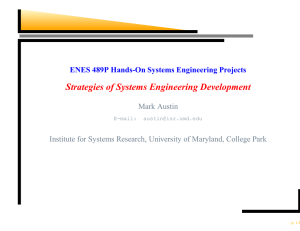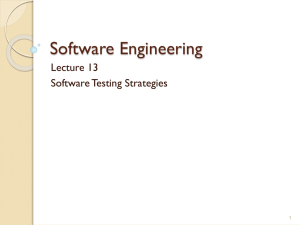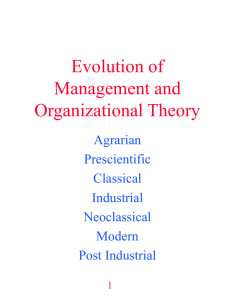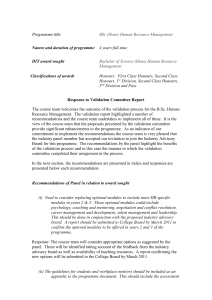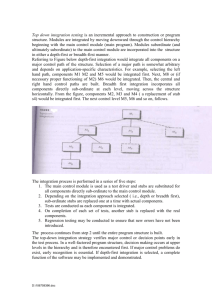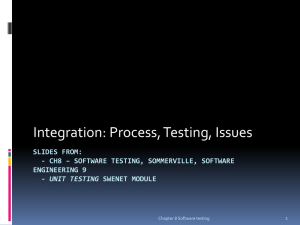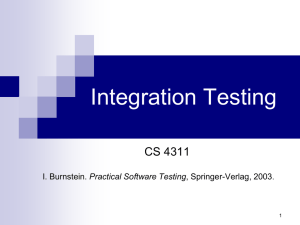Presentation
advertisement
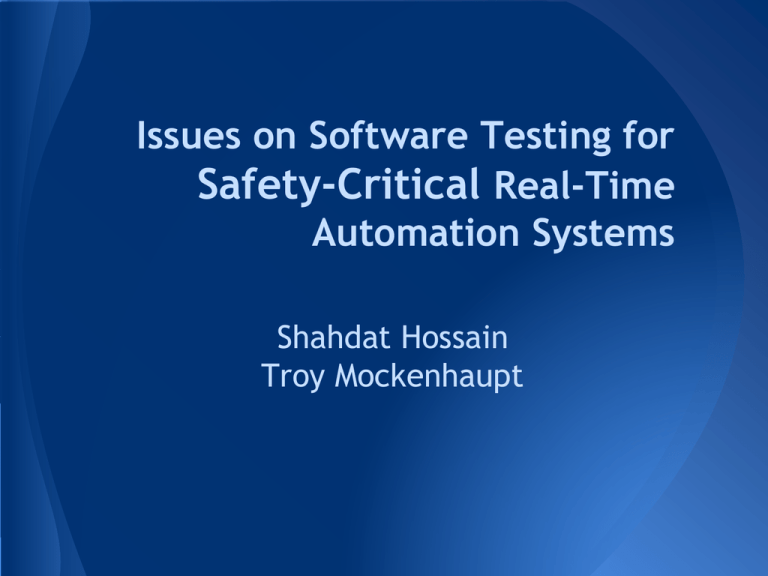
Issues on Software Testing for Safety-Critical Real-Time Automation Systems Shahdat Hossain Troy Mockenhaupt Introduction • Increasing complexity • Reliability depends on many factors • Systematic and effect testing are highly necessary • Full avoidance of human mistakes is not realistic • Thorough testing can ensure software quality Introduction(cont.) • Testing as an inverse to design • Present expected results • Separate development and testing teams • Regression testing at every development modification • Concentrate on error-prone program segments Functional Software Testing Strategies • Big bang testing • Incremental testing • Black Box testing • White Box testing Black Box Testing • Functional testing of the program • Anticipated functionality and desired performance • Not complete software testing • Representative test cases • Boundary value conditions • Error guessing White Box Testing • Inner structure • Cases are specified for exercising specific internal structure • Examine as many logic paths as possible • Logic conditions should be tested at least once • Should be combined with black box testing Software Testing Processes and Steps • Unit Testing • Integration Testing • Validation Testing • System Testing Unit Testing • White Box test cases • Inspecting outputs • Examine basic software unit • Test each module after it is programmed • Module Interface • Crucial execution paths • Exception handling • Local data structure • Boundary value testing Integration Testing • Testing of the subsystem • Black box testing • One module at a time • Top-Down and Bottom-Up approaches Top-Down Integration Testing • Starts with Root module • Subordinate modules are substituted by stubs • Subsystems are creating by replacing stubs • Regression testing • Verify all modules have been included in the subsystem Bottom-Up Integration Testing • Lower level modules first tested • Parallel testing • Driver module uses stub • Driver module is replaced to form subsystem • Finished when root node is reached Validation Testing • Occurs after integration testing • Validate that the software fulfills user requirements • Uses black box testing • Software defects report • Standards defined in the SRS System Testing • Occurs after validation testing • Works as a component of the overall system • Objective is to find discrepancies • • between actual performance and expected performance Based on requirements analysis description "On-site" testing Non-Functional Software Performance Testing • Complex software systems • The process of • validation and verification requires a larger amount of testing cases. Embedded Real Time Applications Availability Testing • Meeting the time constraints. • Missing the deadline for responding to an operation is deemed as a failure as it may incur system malfunction. Reliability Testing • Low reliability system may cause damage. • It is highly concerned with hardware and other support software Survivability Testing • Fault tolerant capability • Quick recovery capability • Specific fault tolerant control algorithms required Flexibility Testing • Multiple requirements and OS • 3rd party drivers and components • Self reconfiguration Stress Testing • Stress testing is to test the software by pushing the system to its limits. Security Testing • System security during all the phases of software life cycle. • Virus and safety-critical automation software systems Usability Testing • Comfortability with the user's experience • GUI design • Increase efficiency • Reduce possiblity of invalid operations Maintainability Testing • The released software needs to be revised and upgraded during its life cycle, therefore, it is highly desirable that the software can be easily maintained. Software Maintenance • software maintenance in the entire software life cycle Corrective Maintenance • After the software is installed on the user sites, it is possible that during system operations, the latent software defects are exposed, and therefore corresponding software revision is needed to ensure the proper running of the software Adaptive Maintenance • Its intent is to ascertain that the released software can adapt to new requirements, which are however not in the previous design specification Perfective Maintenance • New technologies need to be incorporated into the existing software in order to improve its performance Preventive Maintenance • The final type of software maintenance • • is preventive maintenance. It involves making changes to the software that makes future maintenance activities easier to carry out. Check for Software Update frequently Ability to automatically insall latest patches Conclusion • Ensuring the software’s compliance with the user requirements • Software testing is indispensable in safety critical systems • All functional and non functional testings needs to be implemented thoroughly

